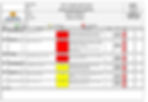Flexible Maintenance Footprint
Aligning Maintenance Strategies to Successfully Impact Organization Bottomline

Equipment Availability
-
Reduce mean-time-to-repair (MTTR) up to 50%
-
Elimination of equipment breakdown on average by 70%-75%
-
Accumulative reduction in total downtime by 35%-45%
Streamline Maintenance Activities
-
Eliminate unnecessary costs of maintenance or overhauls
-
Focus maintenance activities on critical equipment
-
Significantly reduce standby electricians, mechanics and other personnel in case of equipment breakdown
Time & Resources for Restoration
-
Lower Inventories necessary
-
Reduce overall Scheduled & Unscheduled equipment downtown by limiting intrusive maintenance activities to as-needed only
-
Eliminate costly equipment restoration (schedules or unscheduled) that creates budget overruns

Reduce Labor and Parts
Decrease cost of Parts & Labor by equipping personnel with GAP-1 Tools & Techniques that can accurately monitor a fleet equipments at the same time allowing streamline maintenance activities.

Guardian Angel Program is an equipment condition-based monitoring platform that employs non-intrusive inspection techniques that equips management with intuitive tools that predicts critical hardware failures in order to increase availability, streamline maintenance activities, allocate time and resources for restoration and curtail costly downtime.
Equipment Availability
Total Cost of Ownership
GAP-1 Roadmap
Risk assessment is an effective problem statement descriptor-tool that identifies manufacturer’s vulnerability through real worst-case scenarios and its cause-and-effect impacts. Based on such risk profiles, innovative technology and sophisticated maintenance techniques are developed in order to meet risk mitigation requirements. In efforts to avert costly episodes, AGP understands that providing equipment reliability is key to significantly reduce risk, upend productivity, and better positioning our clients competitively. Guardian Angel Program (GAP-1) is an equipment condition-based monitoring platform that employs non-intrusive inspection techniques that equips management with intuitive tools that predicts critical hardware failures to increase availability, streamline maintenance activities, allocate time and resources for restoration and curtail costly downtime. It is made possible with GAP-1 Five-Step Process:
Build Performance Profile
Match the right inspection method with the organization's top-level Reliability & Availability Requirements
Identifying Critical Equipment & Components. Tagging and Mapping is an important and rigorous process that requires precision-intensive documentation of each individual equipment that will be monitored. Such precise information is used to determine:
-
Inspection Method in accordance with the PF-Curve tailored to each equipment
-
Level of Equipment Criticality with respect to production process and cost of restoration
-
Parts to Replace and Restore
-
Ideal Performance Percentage
-
Asset Utilization Rate
Documentation is utilized not only to develop robust Maintenance Footprint, but as well as providing information such as:
-
Trends of Performance
-
Ability to Adjust Overall Production Volume
Develop Maintenance Program Footprint
3

Maintenance Program Footprint.
Monitor Equipment Condition (online/offline)
4




Maintenance Program Footprint. is an equipment condition-based monitoring platform that employs non-intrusive inspection techniques that equips management with intuitive tools that predicts critical hardware failures in order to increase availability, streamline maintenance activities, allocate time and resources for restoration and curtail costly downtime.
Motor #1
Status: Alarm 1
Condition: Looseness & Misalignment Detected
Availability: follow-up failure condition in 2 weeks


1
2
Build Performance Profile

Establish Reliability & Availability Requirements

P-F Curve (also known as Reliability Curve) is an intuitive symbolic representation of equipment potential failure as it progresses to functional failure. In engineering conceptual terms: equipment failure is treated as process, not an event. All equipment are constrained to stress-level thresholds (ideal environment and utility that enables performance) and are subjected to conditions that can speed-up or slow-down its deterioration process. PF-Curve embodies a graphical representation of equipments gradual loss of function caused by multivariable industrial conditions (e.g. rate of use, mix production, operator errors) as time lapses. Thus, AGP employs the PF-Curve to help our clients align the appropriate inspection method for detecting failure modes at an incipient stage in order to provide ample time to Plan & Schedule restoration of faulty components with minimum production interruption.
Motor #2
Motor #3
Status: Ready-to-Run
Condition: No Fault Detected
Availability: Normal Wear life-cycle
Status: Ready-to-Run
Condition: No Fault Detected
Availability: Normal Wear life-cycle
Analyze & Track Failure Modes
5
Maintenance Program Footprint. is an equipment condition-based monitoring platform that employs non-intrusive inspection techniques that equips management with intuitive tools that predicts critical hardware failures in order to increase availability, streamline maintenance activities, allocate time and resources for restoration and curtail costly downtime.
Establish Reliability & Availability Requirements
Step One
Step Two
Step Three
Step Four
Step Five
Develop Maintenance Program Footprint
Monitor Equipment Condition (Online/Offline)
Analyze & Track Failure Modes




